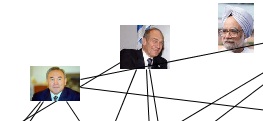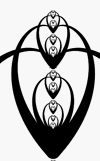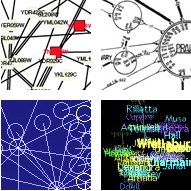 (Sparkline of US deficit over time) Sparklines: theory and practice is a thread in Edward Tufte’s Ask E.T. forum (which is a great place to follow discussions on design issues.) The thread starts with images of some pages from Tufte’s new book, Beautiful Evidence (2006) on sparklines which are defined as “intense, simple, word-sized graphics”. The sparkline at the beginning of this entry is from the Sparkline PHP Graphing Library. Another source of sparkline tools is Bissantz sparkline tools. Thanks to Shawn for this link.
(Sparkline of US deficit over time) Sparklines: theory and practice is a thread in Edward Tufte’s Ask E.T. forum (which is a great place to follow discussions on design issues.) The thread starts with images of some pages from Tufte’s new book, Beautiful Evidence (2006) on sparklines which are defined as “intense, simple, word-sized graphics”. The sparkline at the beginning of this entry is from the Sparkline PHP Graphing Library. Another source of sparkline tools is Bissantz sparkline tools. Thanks to Shawn for this link.
So how can sparklines be woven into text anlysis environments? Small distribution graphs could be included with lists of word or KWIC displays in tools like the TAPoRware tools.
McMaster University Library » Blog Archive » Cyberinfrastructure and CNI
McMaster University Library is a blog just started by our new University Librarian, Jeffrey Trzeciak. Its good to have a Librarian who is comfortable with things like blogs and is willing to try them.
Download Pertinence Summarizer – Text Mining Solutions
 PertinenceMining.com is a French company that has a number of neat text processing products built on their KENiA or “Knowledge Extraction and Notification Architecture.” One their products is Connivences.info which produces maps of “actors” in the news with weighted lines to indicate relationships.
PertinenceMining.com is a French company that has a number of neat text processing products built on their KENiA or “Knowledge Extraction and Notification Architecture.” One their products is Connivences.info which produces maps of “actors” in the news with weighted lines to indicate relationships.
Another interesting tool is their Google + Pertinence Summarizer that enhances the results from Google with a “Summarize” button which splits the linked page into sentences and tries to rank their pertinence to the document so you can choose to see only the most pertinent. The interface took me a while – I’m not sure it works.
DadaDodo: Exterminate All Rational Thought
DadaDodo is a text generator or “travesty generator” like Dissociated Press. The code is available and unlike programs that randomly cut up text it “it scans bodies of text, and builds a probability tree expressing how frequently word B tends to occur after word A, and various other statistics; then it generates sentences based on those probabilities.” DadaDodo is described by its creator Jamie Zawinski thus:
DadaDodo is a program that analyses texts for word probabilities, and then generates random sentences based on that. Sometimes these sentences are nonsense; but sometimes they cut right through to the heart of the matter, and reveal hidden meanings.
Zawinski’s page has a “cut up” look with downloadable code and interesting links, many of which are no longer active, alas. The effect of DadaDodo are hard to interpret without knowing what the corpus is that it starts with. I am tempted to create a TAPoRware version so that it can be used on existing web pages.
ACLS Commission on Cyberinfrastructure for the Humanities & Social Sciences
ACLS Commission on Cyberinfrastructure for the Humanities & Social Sciences has released their final report.
Their recommendates are:
- Invest in cyberinfrastructure for the humanities and social sciences, as a matter of strategic priority
- Develop public and institutional policies that foster openness and access
- Promote cooperation between the public and private sectors
- Cultivate leadership in support of cyberinfrastructure from within the humanities and social sciences
- Encourage digital scholarship
- Establish national centers to support scholarship that contributes to and exploits cyberinfrastructure
- Develop and maintain open standards and robust tools
- Create extensive and reusable digital collections
I note that the development of robust tools is one of the recommendations (along with open standards). See my earlier post Humanities Cyberinfrastructure.
Communications From Elsewhere »
Communications From Elsewhere is a journal (not blog!) by Josh Larios with some interesting text generators including a Postmodernism Generator which randomly generates “completely meaningless” essays using a modified version of The Dada Engine written by Andrew C. Bulhak.
For more on The Dada Engine see the technical report from Monash University, On the simulation of postmodernism and mental debility using recursive transition networks. The Abstract reads:
Recursive transition networks are an abstraction related to context-free grammars and finite-state automata. It is possible, to generate random, meaningless and yet realistic-looking text in genres defined using recursive transition networks, often with quite amusing results. One genre in which this has been accomplished is that of academic papers on postmodernism.
Josh has collected and connected different “Text Generators” to his journal, including an Adolescent Poetry Corner and a Time Cube screed generator. (For an explanation of Gene Ray’s Time Cube theory see DmitryBrant.com ¬ª On Time Cube. The Time Cube site is another story.)
BBC: Text analysis of texting to catch criminals
The BBC have a story on Texting study to catch criminals by researchers at Leicester University in the School of Psychology. They are studying the individual styles of text messages in order to help with forensic investigations. The BBC had previously reported how Text messages examined in Danielle case had helped in the prosecution of the 15-year-old Danielle Jones’ uncle who seems to have sent text messages from Danielle’s phone in order to throw off the scent.
The Leicester University researchers have a web page that welcomes people willing to submit samples. I wonder how useful anonymously submitted messages will be. I imagine, if they get enough messages, it will give them a control sample for the study of particular suspect messages.
Comments Please
Dear readers,
I have turned on commenting again. To combat spam I have installed a plug-in that will ask you to answer a simple math challenge (as in “add 3 and 8”). Please try it out and e-mail me if it doesn’t work.
Geoffrey Rockwell
mandalabrot.net
 mandalabrot.net is the home of kiddphunk (Ian Timourian) and his visualizations, experiments and remixes. He has a number of Context Free Design Grammar experiments. Timourian also has a photo kiddphunk site with an doubled way of showing images.
mandalabrot.net is the home of kiddphunk (Ian Timourian) and his visualizations, experiments and remixes. He has a number of Context Free Design Grammar experiments. Timourian also has a photo kiddphunk site with an doubled way of showing images.
Thanks to Johnny R. for pointing me to this collection of “Explorations of Generative Art, Mathematics, Algorithmic Design and the Beauty of Life / Vol 1”.
visualcomplexity.com | A visual exploration on mapping complex networks

VisualComplexity.com intends to be a unified resource space for anyone interested in the visualization of complex networks. The project’s main goal is to leverage a critical understanding of different visualization methods, across a series of disciplines, as diverse as Biology, Social Networks or the World Wide Web. I truly hope this space can inspire, motivate and enlighten any person doing research on this field. (From the About page.)
I discovered this through the del.icio.us.discover project. We need a comparable collection of text visualization projects.